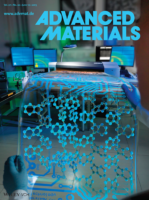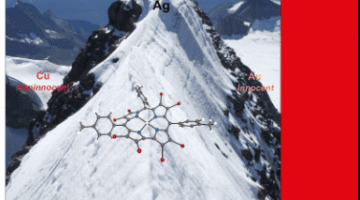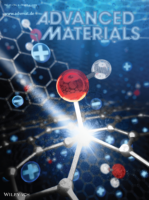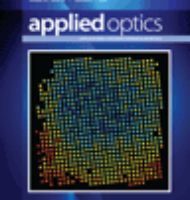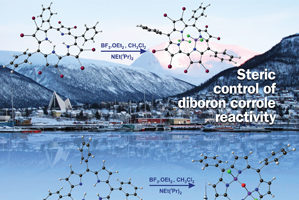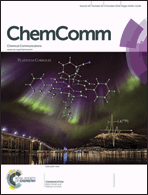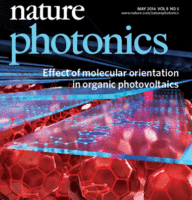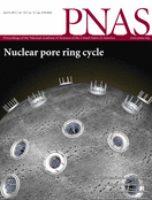Organic electronics have emerged into a highly interesting field of research with a great variety of applications. P. Müller-Buschbaum and co-workers demonstrate the importance of in situ investigations during the printing process of organic electronics. In situ grazing-incidence wide-angle x-ray scattering is used to follow the crystallization process of highly conductive PEDOT:PSS polymer mixtures. These findings are important for tuning transparent polymeric electrodes for organic electronics. Cover Image by Christoph Hohmann, Nanosystems Initiative Munich (NIM). Read more »
Journal Covers
Ligand Noninnocence in Coinage Metal Corroles: A Silver Knife-Edge
In contrast to noninnocent copper corroles and essentially innocent gold corroles, silver corroles appear to be poised on a knife-edge between the two electronic-structural descriptions. The summit trail of Mount Sir Alexander, a peak of the Canadian Rockies described by mountaineer Chris Goulet as a knife-edge that only a mouse can walk on, provides anRead More Read more »
Electronic Structure Changes in Supercapacitor Electrodes Observed In Operando
Profound bias- and time-dependent changes in the electronic structure of graphene-based supercapacitor electrodes are demonstrated under operating conditions via a combination of in operando x-ray spectroscopy and ab initio modeling by J.R.I. Lee and co-workers. The evolution in electronic structure reflects changes in the surface chemistry and morphology induced by polarization of the electrode-electrolyte interface and points to distinct pseudocapacitive and electric-double-layer capacitive channels for charge storage. Read more »
MOF Coating a Promising Path to White LEDs
Hu et al. designed a new yellow phosphor with high quantum yield by immobilizing a preslected chromophore into the rigid framework of a metal–organic framework (MOF); the structure was determined at Beamline 11.3.1. Coating a blue light-emitting diode (LED) with this compound readily generates white light with high luminous efficacy. The new yellow phosphor demonstrates great potential use in phosphor-converted white LEDs. Read more »
Advances in Lithography
Work featured on Applied Optics cover from ALS Beamline 11.3.2. Field-dependent wavefront aberration distribution of an extreme ultraviolet single-lens zone-plate microscope, recovered by the gradient descent algorithm customized for partially coherent imaging and targeted for fast and accurate retrieval. Read more »
Mono- and Diboron Corroles: Factors Controlling Stoichiometry and Hydrolytic Reactivity
The synthesis and structural characterization of a diboryl triaryloctabromocorrole complex fills in a missing link in the family of diboron porphyrinoids. DFT calculations suggest that a strongly electron-withdrawing corrole ligand is required to stabilize the diboryl complex relative to the partially hydrolyzed diboron corrole complexes previously observed. New monoboryl corrole complexes are described, which do not have counterparts in porphyrin chemistry and are stabilized by internal F···H hydrogen bonding. Read more »
Platinum Corroles
Platinum has been inserted into corroles for the first time and three oxidized PtIV(corrole˙2−)ArAr′ complexes have been structurally characterized. The Soret maxima of these complexes exhibit an unusually strong dependence on the meso-aryl substituents on the corrole, indicating aryl → corrole˙2− charge transfer character in these transitions. Read more »
The influence of molecular orientation on organic bulk heterojunction solar cells
Work done on ALS Beamlines 11.0.1.2, 7.3.3, and 5.3.2.2. reveals that preferential orientation of polymer chains with respect to the fullerene domain leads to a high photovoltaic performance. Read more »
Crystal Nucleation and Near-Epitaxial Growth in Nacre
Nacre–the iridescent inner lining of many mollusk shells– has a unique strcuture that is remarkably resistant to fracture. The nacre featured on this cover is from Haliotis laevigata with average layer thickness 470-nm. The colors represent crystal orientationthe crystal lattice tilts across tablets.left stack all tablets are yellow, hence all aragonite crystals are co-oriented. Read more »
Ring Cycle for Dilating and Constricting the Nuclear Pore
Pictured is an illustration of several nuclear pore complexes (NPCs) embedded in a cell nucleus. NPCs act as gatekeepers between a cell’s cytoplasm and its nucleus. Based on crystallographic analyses, Sozanne R. Solmaz et al. uncover the molecular mechanism that underlies the large changes in diameter of NPCs and suggest a “ring cycle” mechanism for dilating and constricting the central NPC channel. The model could explain the ability of NPCs to accommodate transport substrates of a large size range and rapidly adjust to cellular transport needs. Read more »
